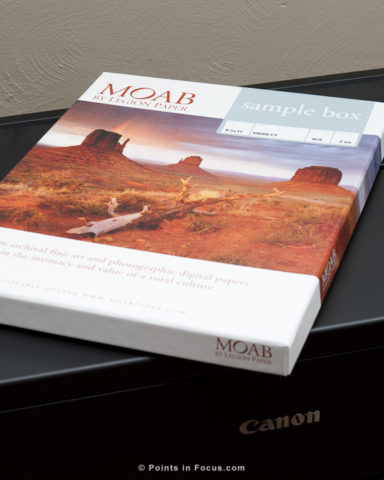Further Down the Rabbit Hole: Moab Paper Sample Pack
Before getting my Pixma Pro 9000 Mk. II, what I printed on was hardly a consideration. There wasn’t much of a point to running anything other than cheap Canon paper though my little Pixma iP4700, and larger prints were outsource to a lab; practically the choice of paper was whatever the lab used. Having a reasonable quality inkjet however, opens the door to a whole other world of paper to deal with.
So, what brought me to Moab Paper first?
I wish I could say it was their reputation, quality, etc., etc. but the truth is it was little more than luck of the draw. I happened to run across this video by Andy Biggs, which showed off the rather nice Moab Chinle Digital Book. I was intrigued, and since the book uses pre-drilled Moab papers, it meant I needed to figure out how their papers looked and felt. Of course, it’s not as though Moab wasn’t on my list, they just weren’t at the top, until now.
Fortunately, Moab—like most paper manufacturers—sells a sample pack. In their case, it’s a 26-sheet box containing 2 sheets each of the following papers:
- Entrada Rag Bright 190
- Entrada Rag Bright 300
- Entrada Rag Natural 190
- Entrada Rag Natural 300
- Colorado Fiber Gloss 245
- Colorado Fiber Satine 245
- Lasal Photo Gloss 270
- Lasal Exhibition Luster 300
- Lasal Photo Matte 235
- Somerset Enhanced Velvet 225
- Somerset Museum Rag 300
- Anasazi Canvas Premium Matte 350
- Kayenta Photo Matte 205
- Slickrock Metallic Pearl (new as of July 19th)
I expect to write more about most of the papers individually in coming posts, though I doubt I’ll get real quantitative about them. For now, I just wanted to spend a moment to talk about the sample pack.
The 26 sheets are packed in a single poly bag in the box and are identified by a label affixed to the back of each sheet. Easy enough to deal with and easy enough to find what you want to print on. I do wish that paper companies would start using bags with the adhesive on the body instead of the flap though.
With respect to the paper itself, I really like the weight and feel of it. Yes, I know you shouldn’t handle fine-art prints, but most of the papers, especially the heavy matte ones, are just so nice.
On the down side, leafing through the box looking at the stock I noticed many of the sheets aren’t perfect; most of the matte papers have minor dark “marks” or “spots” for lack of a better word; not exactly ideal for high-key prints dominated by light or white colors. The gloss and semi-gloss papers were considerably better in that respect. Additionally, at least one sheet of the Entrada 300 paper in my box was noticeable crushed along part of the surface.
That said, I’m not sure how to read into any of that. The crushed sheet is obviously a defect, and something I’d definitely want to have replaced if this wasn’t a sample/test box. The spots on the other hand, I’m not sure if they are a defect, or part of the “character” of the sheet, and even then how much of an issue they’d ever really be in a print versus just inspecting the blank sheet.
The real test, of course, will be to see how prints look.
Update: Shortly after this article went live, I was contacted by Mark Schotland from Legion Paper (the people who make the Moab branded papers) about my issues with the sample box I received. Quite simply put, he felt that I shouldn’t have had paper with spots, marks on it, or that was crushed, and offered to send me a replacement sample box on their dime.
The replacement box has since arrived and a thorough visual inspection of the paper contained in the box revealed no crushed sheets, or sheets with spots or marks. Further the replacement box was shrink wrapped and contained a folded paper flyer detailing the papers included. Neither of which were the case, with my first sample pack (which wasn’t ordered from Moab directly but though a well regarded retailer); additionally on closer examination my first sample pack was missing one type of paper, and had more than double of another.
What’s definitely clear is that the first sample pack I received was not what it should have been. Moreover, since I didn’t order it directly from Moab, I don’t really know whether it was a mix up on their end when assembling the box or whether someone at the retailer I bought it from tampered with it. Either way, the replacement box doesn’t have any of the differences in paper quality or stock counts that the first one did.
Moreover, I feel that Moab has gone out of their way to address these issues. Including working with me to determine why I was seeing color shifts in my Colorado Gloss prints, and ultimately offering to build me a custom ICC profile for that paper to insure I got the best images out of their papers. Not only have they been helpful and professional but they’ve stood behind their product and worked to insure I had the best experience possible with their paper.
